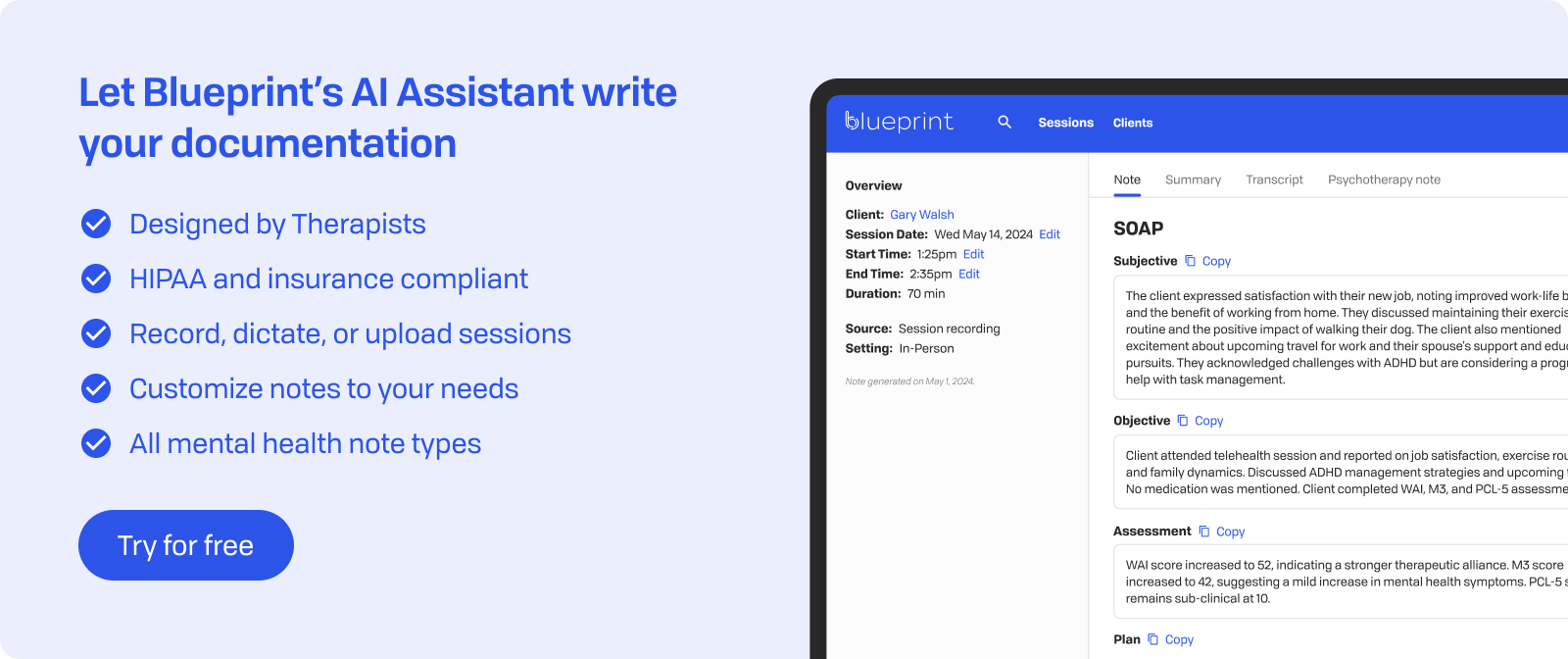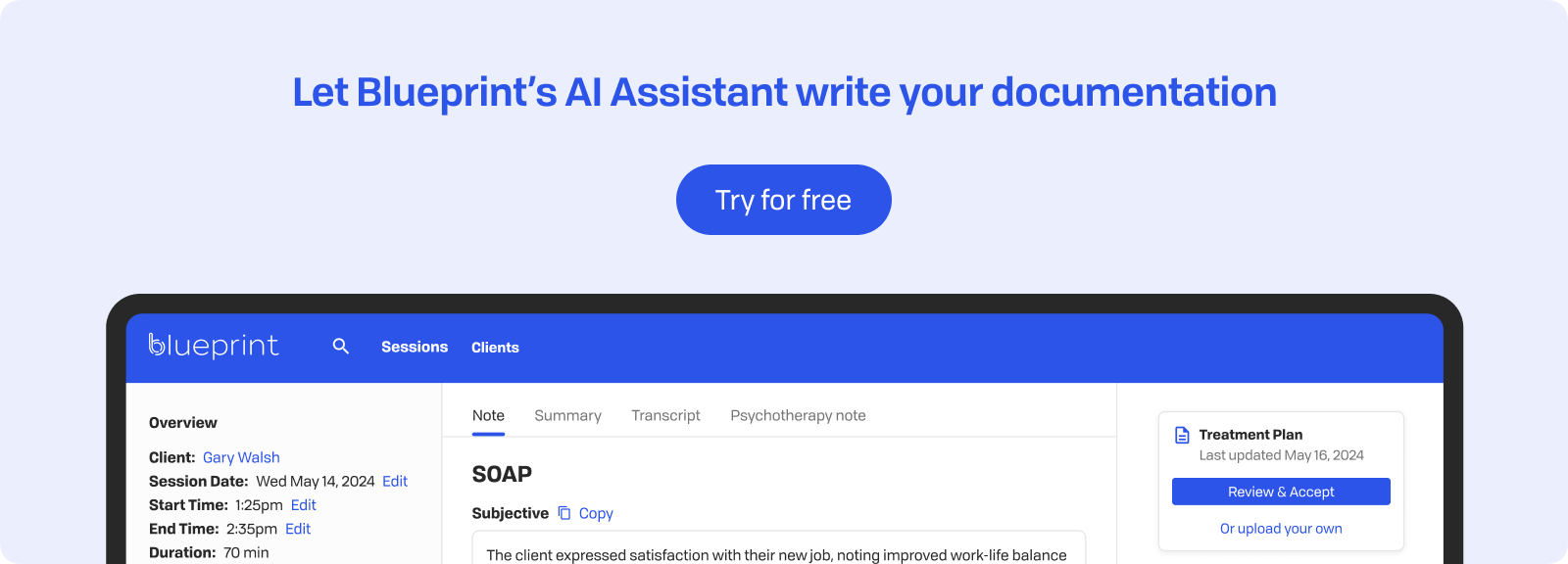
In Brief
You've probably experienced those key moments in sessions when a client suddenly opens up, sharing something they've never told anyone before. Or perhaps you've noticed how a simple shift in your tone or posture completely changed the dynamic in the room. These aren't accidents, they happen because of skillfully applied therapeutic communication.
The line between a regular conversation and a therapeutic exchange is subtle but significant. While everyday conversations flow naturally, therapeutic communication requires careful choices about every word, pause, and gesture. This approach determines whether clients feel truly heard or just listened to.
Research consistently shows that the quality of the therapeutic relationship strongly predicts treatment success. Tools like the Working Alliance Inventory and the Agnew Relationship Measure confirm what experienced clinicians know: how we communicate matters as much as what we communicate. You can learn, practice, and refine the techniques that strengthen this important connection.
Defining Therapeutic Communication
Therapeutic communication is a deliberate clinical skill that goes beyond ordinary conversation. It combines empathy, strategic validation, and purposeful structure to create meaningful therapeutic encounters. Unlike casual dialogue, every element serves a specific clinical purpose.
At its core, therapeutic communication builds and maintains the trust needed for effective treatment. It creates a safe space where clients can explore difficult emotions, challenge long-held beliefs, and practice new ways of being. This form of interaction requires therapists to balance professional boundaries with genuine warmth and connection.
The therapeutic alliance, that unique bond between therapist and client, relies entirely on the quality of communication. When done well, therapeutic communication transforms the therapy room into a place where healing can happen. It's the vehicle for delivering all other interventions and the foundation for achieving successful outcomes.

Core Principles of Therapeutic Communication
Therapeutic communication builds on three interconnected principles that shape meaningful clinical encounters. These principles guide each interaction and help create the conditions necessary for therapeutic change.
Active listening without judgment serves as the cornerstone of effective therapeutic communication. This involves:
- Being fully present: Paying complete attention to both verbal and nonverbal messages
- Putting aside assumptions: Letting go of personal biases and preconceptions
- Emotional awareness: Recognizing and responding to the emotions beneath the words
- Client-centered approach: Maintaining genuine curiosity about the client's unique experience
Open-ended questions encourage exploration and help clients gain their own insights. Instead of looking for specific answers, these questions prompt clients to:
- Expand on their thoughts and feelings
- Connect various experiences
- Examine ambivalence and contradictions
- Build self-awareness through expression
Examples include "What was that like for you?" or "Tell me more about that feeling."
Clarification, reflection, and summarizing build shared understanding between therapist and client. These techniques ensure accurate comprehension while showing attentiveness:
- Clarification: "When you say 'overwhelmed,' what does that feel like in your body?"
- Reflection: "You're noticing a pattern of withdrawing when you feel criticized"
- Summarizing: "Let me see if I understand, you're torn between wanting connection and fearing rejection"
These principles work together. Active listening lays the groundwork for meaningful questions, which produce material for clarification and reflection. Collectively, they form a therapeutic dialogue that promotes insight, validates experience, and supports change.

Verbal Techniques in Practice
Choosing the right words can turn ordinary dialogue into meaningful therapeutic exchanges. These intentional choices in how we speak, and don't speak, create opportunities for deeper exploration and healing.
Silence stands as one of the most underused yet powerful tools in therapeutic communication. Instead of filling every pause, intentional silence:
- Gives clients a chance to process emotions and thoughts
- Encourages deeper reflection beyond surface-level responses
- Allows important insights to surface naturally
- Shows patience and presence without words
Many therapists feel uneasy with silence, especially in the early stages of training. One tip to consider using during a moment of silence, count slowly to seven. If the client doesn’t respond by the time you get to seven, you can gently re-engage without rushing to fill the space. Sometimes this means offering a supportive reflection (“I notice the pause, maybe you’re thinking about how to put something into words”), or simply checking in (“What’s coming up for you right now?”). This approach keeps the silence intentional rather than awkward, while still leaving the door open for the client to share at their own pace.
Validation and affirmations invite authentic client expression while building trust. These techniques go beyond simple agreement:
- Emotional validation: "It makes complete sense you'd feel angry after that betrayal."
- Normalizing responses: "Many people in your situation would feel similarly overwhelmed."
- Strength-based affirmations: "I notice how you advocated for yourself in that moment."
- Process acknowledgment: "The courage it takes to share this is significant."
Gentle confrontation addresses discrepancies without harming the therapeutic relationship. This technique requires careful timing and delivery:
- Highlighting contradictions: "I'm noticing you describe feeling fine, yet your arms are folded around your chest and your shoulders and face look tense."
- Exploring patterns: "Have there been any other times in your life where something similar happened in your previous relationship."
- Inviting curiosity: "What do you make of the difference between what you're saying and feeling?"
These verbal techniques create a therapeutic environment where clients feel safe to explore difficult topics while being encouraged to grow.

Nonverbal Communication in Therapy
Your nonverbal cues often communicate more than your words. So much emotional communication occurs through nonverbal channels, making your body language, facial expressions, and physical presence important therapeutic tools.
Eye contact, posture, and tone serve as important therapeutic signals that either invite connection or create distance:
- Eye contact: Maintaining appropriate eye contact shows engagement and attentiveness, while being mindful that too much can feel intrusive.
- Posture: Leaning slightly forward demonstrates interest; crossed arms might signal defensiveness.
- Vocal tone: A calm, steady voice conveys safety even when discussing difficult topics.
- Facial expressions: Matching appropriate concern or warmth to the client's emotional state.
Creating safety through physical environment and body language involves more than individual gestures. The therapy space itself communicates welcome and confidentiality through:
- Comfortable seating arrangements that allow choice and an appropriate amount of space between therapist and client.
- Soft lighting and calming colors.
- Minimal barriers between therapist and client (e.g., no desks or large coffee tables).
- Consistent, predictable positioning session to session.
Cultural and individual differences significantly impact nonverbal interpretation. What feels supportive in one culture might seem intrusive in another:
- Personal space preferences: Vary widely across cultures and individual comfort levels.
- Eye contact norms: Direct gaze shows respect in some cultures, disrespect in others.
- Touch boundaries: Handshakes, high-fives, or no physical contact depend on cultural background and personal history.
- Emotional expression: Some clients express freely through gestures; others remain still when processing deep emotions.
Grasping these nuances helps you adjust your nonverbal communication to each client's unique needs and cultural context.
Overcoming Barriers to Communication
Even skilled therapists meet clients who find it hard to engage fully in the therapeutic process. Identifying and addressing these barriers calls for flexibility, patience, and an ability to adjust your communication style to connect with each client.
Working with guarded, resistant, or ambivalent clients involves specific strategies:
- Start where they are: Accept their reluctance without pushing for immediate openness.
- Explore the resistance: "I'm sensing some hesitation about discussing this—what is this process like for you?"
- Offer choices: Let clients control the pace and topics of discussion.
- Acknowledge ambivalence: "It sounds like part of you wants change while another part feels safer with how things are."
Neurodivergent clients and those with trauma histories often require modified communication approaches:
- Clear, concrete language: Avoid metaphors or abstract concepts that might confuse.
- Predictable structure: Maintain consistent session formats to reduce anxiety.
- Sensory considerations: Adjust lighting, sound levels, or seating based on individual needs.
- Trauma-informed pacing: Allow extra time for processing and avoid rushing responses.
Managing therapist communication pitfalls needs ongoing self-awareness:
- Over-talking: Notice if you're filling silence out of your own discomfort.
- Premature interpretations: Hold hypotheses lightly and check with clients before assuming.
- Personal assumptions: Regularly examine how your own experiences might color your understanding.
- Rushing to solutions: Resist the urge to problem-solve before fully understanding the client's experience.
These barriers aren't roadblocks—they offer chances to show adaptability and strengthen the therapeutic relationship through thoughtful communication adjustments.

Applying Communication Techniques Across Modalities
Different therapeutic approaches call for specific communication styles to meet their goals. Knowing how to adjust your communication techniques across various methods enhances your effectiveness, no matter which framework you use.
CBT uses directive, structured communication focused on present concerns:
- Socratic questioning: "What evidence supports that thought?" helps clients examine beliefs.
- Collaborative language: "Let's explore together" highlights the working partnership.
- Clear psychoeducation: Using concrete examples and metaphors to explain cognitive concepts.
- Goal-oriented dialogue: Keeping conversations centered on specific, measurable outcomes.
Psychodynamic therapy involves more exploratory, open-ended communication:
- Free association encouragement: "Say whatever comes to mind" invites unconscious material.
- Interpretive observations: "I wonder if this connects to..." links past and present.
- Process comments: Noting what's happening in the moment between therapist and client.
- Tolerance for ambiguity: Allowing multiple meanings to coexist without rushing to conclusions.
Systemic therapy tailors communication for multiple participants:
- Circular questioning: "How do you think your mother feels when..." uncovers relational patterns.
- Reframing statements: Offering alternative perspectives on family dynamics.
- Balancing attention: Ensuring all voices are heard while managing dominant speakers.
Group therapy presents unique communication challenges requiring skills to manage multiple relationships simultaneously while maintaining therapeutic focus. Facilitators must balance individual needs with group dynamics, using techniques like linking member experiences and managing cross-talk effectively.
Telehealth requires intentional adjustments to maintain therapeutic presence through screens. Therapists compensate for limited nonverbal cues through increased verbal check-ins, deliberate eye contact with the camera, and explicit acknowledgment of technical limitations affecting communication flow.
Key Takeaways
Therapeutic communication forms the backbone of effective therapy, creating the right conditions for healing and growth. Without skillful communication, even the most evidence-based interventions may not reach their full impact.
The skills involved in therapeutic communication cover both verbal and nonverbal areas:
- Verbal techniques: Active listening, open-ended questions, validation, and strategic use of silence
- Nonverbal awareness: Eye contact, posture, tone, and environmental considerations
- Adaptive approaches: Tailoring communication style to fit therapeutic modality and client needs
- Cultural sensitivity: Being mindful of how cultural backgrounds influence communication preferences and interpretations
Common barriers to effective therapeutic communication can be addressed through:
- Flexibility: Changing your approach when clients are guarded or ambivalent
- Patience: Letting clients control the pace of disclosure and exploration
- Self-awareness: Being mindful of your own communication habits and biases
- Creativity: Discovering new ways to connect when standard approaches aren't effective
Strong therapeutic communication directly affects treatment outcomes. Research consistently shows that the quality of the therapeutic relationship, built through effective communication, predicts client progress more reliably than specific treatment techniques. When therapists develop these communication skills, they create an environment where clients feel safe to explore difficult emotions, challenge limiting beliefs, and practice new ways of relating to themselves and others.
These skills require continuous practice and refinement throughout your career. Each client interaction offers a chance to enhance your therapeutic communication abilities and deepen the meaningful impact of your work.

How Blueprint can help streamline your workflow
Blueprint is a HIPAA-compliant AI Assistant built with therapists, for the way therapists work. Trusted by over 50,000 clinicians, Blueprint automates progress notes, drafts smart treatment plans, and surfaces actionable insights before, during, and after every client session. That means saving about 5-10 hours each week — so you have more time to focus on what matters most to you.
Try your first five sessions of Blueprint for free. No credit card required, with a 60-day money-back guarantee.























